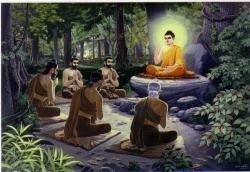 | ||
The Sambhogakāya (Sanskrit: "body of enjoyment", Tib: longs.sku) is the second mode or aspect of the Trikaya.
Contents
Celestial manifestations
The Sambhogakaya is a "subtle body of limitless form". Both "celestial" Buddhas such as Bhaisajyaguru and Amitābha, as well as advanced bodhisattvas such as Avalokiteśvara and Manjusri can appear in an "enjoyment-body." A Buddha can appear in an "enjoyment-body" to teach bodhisattvas through visionary experiences.
Those Buddhas and Bodhisattvas manifest themselves in their specific pure lands. These worlds are created for the benefits of others. In those lands it is easy to hear and practice the Dharma. A person can be reborn in such a pure land by "the transfer of some of the huge stock of 'merit' of a Land's presiding Buddha, stimulated by devout prayer.
One of the places where the Sambhogakāya body appears is the extra-cosmic realm or pure land called Akaniṣṭha. This is one of the highest realms of the Śuddhāvāsa devas.
Absolutely seen, only the Dharmakāya is real; the Sambhogakāya and Nirmanakaya are "provisional ways of talking about and apprehending it".
Access by advanced practitioners
Sambhogakaya also refers to the luminous form of clear light the Buddhist practitioner attains upon the reaching the highest dimensions of practice.
According to tradition, those skilled in meditation, such as advanced Tibetan lamas and yogis, as well as other highly realized Buddhists, may gain access to the Sambhogakaya and receive direct transmission of doctrine.
Tibetan Buddhism
There are numerous Sambhogakāya realms almost as numerous as deities in Tibetan Buddhism. These Sambhogakaya-realms are known as Buddha-fields or Pure Lands.
One manifestation of the Sambhogakaya in Tibetan Buddhism is the rainbow body. This is where an advanced practitioner is walled up in a cave or sewn inside a small yurt-like tent shortly before death. For a period of a week or so after death, the practitioners' body transforms into a Sambhogakaya light body, leaving behind only hair and nails.
Lopön Tenzin Namdak as rendered by John Myrdhin Reynolds conveyed the relationship of the mindstream (Sanskrit: citta santana) of Sambhogakaya that links the Dharmakaya with the Nirmanakaya.
Chán Buddhism
In the Chán (禪) (Jp. Zen) tradition, the Sambhogakāya (Chin. 報身↔baoshen, lit. "retribution body"), along with the Dharmakaya and the Nirmanakaya, are given metaphorical interpretations.
In the Platform Sutra of the Sixth Patriarch, Chan Master Huineng describes the Samboghakaya as a state in which the practitioner continually and naturally produces good thoughts:
Think not of the past but of the future. Constantly maintain the future thoughts to be good. This is what we call the Sambhogakāya.
Just one single evil thought could destroy the good karma that has continued for one thousand years; and just one single good thought in turn could destroy the evil karma that has lived for one thousand years.
If the future thoughts are always good, you may call this the Sambhogakāya. The discriminative thinking arising from the Dharmakāya (法身↔fashen "Truth body") is called the Nirmanakāya (化身↔huashen "transformation body"). The successive thoughts that forever involve good are thus the Sambhogakāya.
